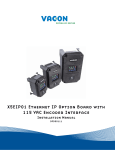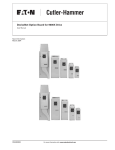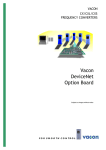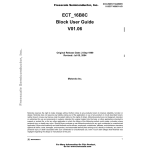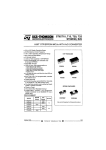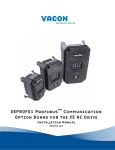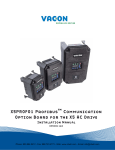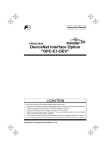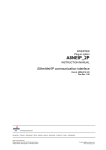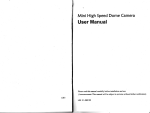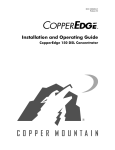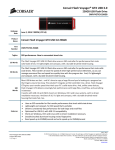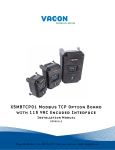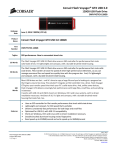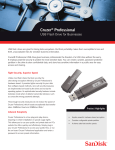Download Form 1436 X5DNET01.fm
Transcript
X5DNET01 DeviceNet™ Communication Option Board for the X5 AC Drive Installation Manual DPD00110 Need Help? This manual answers most installation and startup questions that may arise. However, if you have any problems, please let your first call be to us. Vacon, Inc. Chambersburg, PA 17202 Normal business hours: (North America) 8:00 AM to 5:00 PM, Eastern time +1 877-Vacon06 (+1 877-822-6606) After-hours support is also available and Vacon, Inc. are trademarks of Vacon Plc, a member of Vacon Group. All other product names are trademarks of their respective companies. Copyright 2009, Vacon, Incorporated. All rights reserved. X5DNET01 DeviceNet™ Communication Option Board vacon 3 Installing the X5DNET01 DeviceNet™ Communication Option Board Introduction The X5 frequency converters can be connected to DeviceNet using an option board, the X5DNET01. The converter can then be controlled, monitored, and programmed from the host system. DeviceNet is an open network bsed on Controller Area Network (CAN) standards that is designed to connect lowcost industrial control devices (such as limit switches, photoelectric sensors, motor starters, process sensors, frequency converters, panel displays and operator interfaces) to a network and eliminate expensive hard wiring. The direct connectivity provides improved communication between devices as well as important device-level diagnostics not easily accessible or available through hard-wired I/O interfaces. The DeviceNet model is application independent; it provides the communication services needed by various types of applications. Many of today’s lower-level industrial control devices must retain their low-cost / low resource characteristics even when directly connected to a network. DeviceNet takes this into consideration by defining a specific instance of the model for communications typically seen in a master / slave application. This is referred to as the Predefined Master/Slave Connection Set. DeviceNet allows the interchangeability of simple devices while making interconnectivity for more complex devices possible. In addition to reading the state of discrete devices, DeviceNet provides the capability to report temperatures, to read the load current in a motor starter, to change the deceleration rate of drives, or to count the number of packages that have passed on a conveyor in the previous hour. This option also provides two additional control relays, each rated for 115 VAC, 1 amp, or for 230 VAC, 0.5 amp. NOTE: This network communication interface included with the X5 option is warranted to meet the core specifications for DeviceNet. Many existing software applications are custom-engineered and may contain “brand-specific” communication that will not be supported by the X5 without modification. No guarantee of compatibility with any specific system is made. The user is responsible for any interface software and hardware needed to make an application function. Applicable Documents This manual is supplied as a supplement to the X5 AC Drive User’s Manual (DPD 00089, previously Form 1434). Option Kit Contents The option kit includes the following materials: Part Number Description 25100064C DeviceNet PC board assembly 32100391 Flexible cable assembly Email: [email protected] • Fax 717-264-3115 4 vacon X5DNET01 DeviceNet™ Communication Option Board Installation Procedures ! WARNING SENSITIVE EQUIPMENT This assembly contains static-sensitive components. It should be handled only by a static-safe installer, using a grounded wrist strap. Failure to observe this precaution may cause premature equipment failure. ! DANGER HAZARDOUS VOLTAGE • Disconnect all power before servicing a drive unit or its components. WAIT 5 MINUTES until the DC bus capacitors discharge. • Ensure that any other power sources that may feed control logic have been disconnected. • DO NOT short across DC bus capacitors or touch unshielded components or terminal strip screw connections with voltage present. • Install all covers before applying power or starting and stopping the drive. • The user is responsible for conforming to all applicable code requirements with respect to grounding all equipment. • Many parts in a drive, including printed circuit boards, operate at line voltage. DO NOT TOUCH. Use only electrically-insulated tools. Before servicing any drive. • Disconnect all power. • Place a “DO NOT TURN ON” label on the drive disconnect. • Lock the disconnect in the open position. Failure to observe these precautions will cause shock or burn, resulting in severe personal injury or death. Figure 1 shows the layout of the option board and the location of important components on it. 24-hour support 1-877-822-6606 X5DNET01 DeviceNet™ Communication Option Board vacon Switch 7-6 Set Baud Rate Encoder / 115 VAC Interface Terminals Switch 5-0 Set MAC / Node Address Encoder Interface Power Supply Selector Module Status LED Network Status LED DeviceNet Terminal Block Figure 1: Option board layout Before you can install the option board, you must first remove the drive cover. Figure 2 shows the locations of the cover screws. The torque range for the X5 Size 1 cover is 18-26 in/lbs. Cover screw locations Figure 2: Cover assembly and screw locations Email: [email protected] • Fax 717-264-3115 Cover screw locations 5 6 vacon X5DNET01 DeviceNet™ Communication Option Board The option board is installed just above the control board in all configurations (a Size 1 unit is shown in Figure 3 for reference). The screws labeled “A” must be removed from the X5; those labeled “B” need only to be loosened to accept the board slot. . B B A A Figure 3: Option board mounting locations Once the board is in place, tighten the screws to a maximum of 26 in-lbs. 24-hour support 1-877-822-6606 X5DNET01 DeviceNet™ Communication Option Board vacon 7 Next, install the flexible circuit to finish the interface to the control board. (Refer to Figure 4.) To install the flexible circuit, first remove the keypad frame (necessary in this size unit). The frame is attached with two screws in opposite corners; the screws thread into fasteners in the plastic assembly. After the flexible circuit is installed, replace these screws, limiting the installation torque to 12 in-lbs.. Figure 4: Flexible circuit interface to control board 115 VAC Interface / Relay / Encoder Interface Terminals Figure 5: 115 VAC interface / encoder terminals The option kit includes five 115 VAC inputs, two additional programmable relays, and an encoder interface. The details of the terminals on the board related to the 115 VAC interface and the encoder are shown in Table 1 on page 7: Table 1: Encoder Interface Terminals Terminal Email: [email protected] • Fax 717-264-3115 Description 8 vacon X5DNET01 DeviceNet™ Communication Option Board Table 1: Encoder Interface Terminals DI-A DI-B DI-C DI-D DI-E 115 VAC logic input; connect input to 115 VAC to activate. The programmable functionality of these inputs is controlled by parameters 728, 729, 730, 731, and 732. Each of these inputs can emulate the function of the FWD, REV, R/J, EN, MOL, DI1, DI2, DI3, DI4, or DI5 input terminals on the X5 control board. Refer to the X5 User’s Manual for more information (DPD 00089). ACn The neutral connection for the 115 VAC control inputs NO3 RC3 NC3 The third auxiliary relay. The function of this relay is set by parameter 709. Functionally, it is capable of each of the features outlined in the X5 user manual under parameters 705-708. Terminal NO3 is a normally-open contact; it closes when the relay activates. NC3 is a normally-closed contact; it opens when the relay activates. RC3 is the common terminal associated with both contacts. The ratings of these contacts are 115 VAC, 1 amp; and 230 VAC, 0.5 amp. NO4 RC4 NC4 The fourth auxiliary relay. The function of this relay is set by parameter 710. Functionally, it is capable of each of the features outlined in the X5 user manual under parameters 705-708. Terminal NO4 is a normally-open contact; it closes when the relay activates. NC4 is a normally-closed contact; it opens when the relay activates. RC4 is the common terminal associated with both contacts. The ratings of these contacts are 115 VAC, 1 amp; and 230 VAC, 0.5 amp. A+ A- Channel A input from the encoder. Compatible with line driver, open collector, or totem pole outputs from an encoder. If it is an open collector or totem pole-type, encoder outputs are used; connect the A- terminal to Ecom. B+ B- Channel B input from the encoder. Compatible with line driver, open collector, or totem pole outputs from an encoder. If it is an open collector or totem pole-type, encoder outputs are used; connect the B- terminal to Ecom. C+ C- Channel C input from the encoder. Compatible with line driver, open collector, or totem pole outputs from an encoder. If it is an open collector or totem pole-type, encoder outputs are used; connect the C- terminal to Ecom. VDC Ecom Power supply terminal for use with a customer-supplied encoder. It can be either +12 VDC or +5 VDC based on the position of the encoder interface power supply selector shown in Figure 1 on page 5. Voltage regulation: +/- 5%; maximum current available is 100 mA. Signal common for the encoder interface Note that the connections described in Table 1 work only when the encoder has an internal pull-up resistor on the open collector. Alternatively, it might be preferable to pull the + channel high, and attach the open collector to the channel. For example, if using Channel A, A+ on the option board would be tied to VDC, and A- would be connected to the open collector coming from the encoder. The advantage in this method is that no pull-up/down resistors are needed; if the encoder has an internal pull-up, this does not affect anything. 24-hour support 1-877-822-6606 X5DNET01 DeviceNet™ Communication Option Board vacon 9 Specifications for Encoder / 115 VAC Interface Encoder Interface Speed regulation 115 VAC Interface < 0.1 Hz (1) On state Input frequency (max.) 100 kHz Off state < 10 VAC Input voltage 10-24 VDC +/- 5% Input frequency 58-62 Hz Suggested pull-up resistor Terminal block wire limitations 5 VDC 500 ohms 12 VDC 1k ohms 24 VDC 3.3k ohms 12-24 AWG 90-140 VAC On/off delay 30 ms maximum Terminal block wire limitations 12-24 AWG (1) PID feedback plus optimal motor turning in SLV mode employed Setup and Use The encoder interface is most effective if used in conjunction with the vector mode of operation. Refer to the X5 User’s Manual (Chapter 6) for information about using the vector mode. Three additional parameters are provided to calibrate the encoder: Parameter # Parameter Name Range Default Value 219 Encoder Pulses per Revolution 0-16383 1024 220 Encoder Filter Time 10-1000 ms 20 ms 221 Encoder Speed Protection 0-20.0% 0% Parameter 219, Encoder Pulses per Revolution, can either be extracted from the encoder nameplate or the data sheet supplied with it. Parameter 220, Encoder Filter Time, is used to filter the encoder signal in the event of noise. Parameter 221 is for limiting the response of the drive, in the event of the loss of encoder signal. Two other parameters are provided to allow more flexibility in encoder selection, and to improve PID application usage: Parameter # Parameter Name Range Default Value EncoderType Quadrature or Single Channel Quadrature 223 224 Encoder Range 0-24000 rpm 0 rpm Parameter 223, Encoder Type, allows the use of either quadrature or single-channel types of encoders. Parameter 224, Encoder Range, improves PID application flexibility. This parameter should be used in situations where the encoder feedback signal is not always directly proportional to the motor speed, for example, a winder using an encoder mounted on an idler pulley feeding a winding spool. The PID may be attempting to maintain a constant linear speed on the wound media, but as the diameter of the media on the spool changes, the motor turning the spool needs to vary its speed to maintain the linear speed at the idler pulley. When parameter 224 is set to 0, it is ignored, and the PID calculates the feedback percentage based on parameter 301, Maximum Frequency. When this parameter is set to a non-zero value, the PID uses instead Parameter 224’s setting to calculate the feedback percentage. Encoder feedback works similarly to an analog input as configured in parameters 850 (PID Configure), 851 (PID Feedback), 852 (PID Prop Gain), 853 (PID Int Gain), and 859 (PID Derivative Gain). The “feed forward” options are suggested for setting parameter 850. More specific details on each of the listed parameters can be found in the X5 User’s Manual (DPD 00089). Email: [email protected] • Fax 717-264-3115 10 vacon X5DNET01 DeviceNet™ Communication Option Board The encoder interface can easily serve as one of the inputs to the X5’s Keeper Function (data logging). See the X5 User’s Manual for more information. Both the Vmet and Imet output from the drive can be configured to indicate the status of the encoder. Parameters 700 (Vmet) and 702 (Imet) that relate to the setup and calibration of the Vmet and Imet outputs, both have selections related to the status of the encoder input. The Program Sequencer function can also key off the encoder’s home pulse. To make use of this function, the encoder’s home pulse (1 pulse per revolution) must be connected to the C- input of the encoder board. Encoder Interface Troubleshooting Any problem with the encoder interface will result in an F37 fault. Four advanced fault codes are available to help you determine whether you have an encoder calibration problem, or a defect. For more information on troubleshooting, refer to the Troubleshooting chapter in the X5 User’s Manual. For information on setting parameters, see Chapter 7 in the X5 User’s Manual. Using DeviceNet Connections Following are the specifications for DeviceNet connections: Table 2: DeviceNet Connection Specifications DeviceNet Connections Communications Interface Pluggable connector (5.08 mm) Data transfer method CAN Transfer cable Two-wire twisted shielded cable with two-wire bus power cable and drain Isolation 500 VDC Baud rate 125, 250 and 500 kbaud Product code 0x03 (X5) Product type 0x02 (AC Drive) Vendor ID 509 Device Net Other Network supply voltage: 11 - 25 Vdc Network input current: 28 mA typ., 125 mA inrush (24 Vdc) Table 3 describes the features and functions of DeviceNet. Table 3: DeviceNet Features and Functionality Network size Network length Up to 64 nodes Selectable end-to-end network distance varies with speed Baud rate Distance 125 Kbps 500 m 250 Kbps 250 m 500 Kbps 100 m Data packets 0-8 bytes Bus topology Linear (trunkline / dropline); power and signal on the same network cable Bus addressing Peer-to-peer with Multi-Cast (one to many); Multi-Master and Master / Slave Special case; polled or change of state (exception-based) System features Removal and replacement of devices from the network under power 24-hour support 1-877-822-6606 X5DNET01 DeviceNet™ Communication Option Board vacon 11 Physical Layer and Media The basic trunkline-dropline topology provides separate twisted pair busses for both signal and power distribution. Thick or thin cable can be used for either trunklines or droplines. End-to-end network distance varies with data rate and cable size. Devices can be powered directly from the bus and communicate with each other using the same cable. Nodes can be removed from or inserted in the network without powering down the network. Power taps can be added at any point in the network, which makes redundant power supplies possible. The trunkline current rating is 8 amps. An opto-isolated design option allows externally-powered devices (for example, AC drives, starters, and solenoid valves) to share the same bus cable. Figure 6: Thick or thin cable can be used for either trunklines or droplines The X5DNET01 DeviceNet board is connected to the fieldbus through a 5-pin pluggable bus connector. (See Figure 1 on page 5 for the location of the bus connector.) Communication with the control board of the frequency converter takes place through the flexible circuit applied last during the installation process. DeviceNet Terminals Table 4 describes the DeviceNet terminal assignments: Table 4: DeviceNet Terminals Terminal Description Signal Reference 1 Communication power supply, ground V- 2 Communication signal, low CAN_L 3 Cable shield (bare) Drain 4 Communication signal, high CAN_H 5 Communication power supply, +24V V+ Email: [email protected] • Fax 717-264-3115 12 vacon X5DNET01 DeviceNet™ Communication Option Board LED Indications The DeviceNet Option Board includes two LED status indicators: Network Status and Module Status. See Figure 1 on page 5 for the location of these LEDs on the board. Network status provides information on the network connection status and module status provides information on the DeviceNet module itself. The following tables explain the meaning of the status LEDs: Table 5: Network Status LED Network Status LED If the LED is... This means... OFF The DeviceNet option is not online. - The device has not completed the Dup_MAC_ID test - If the module status LED is off, the device is not receiving power. Green The DeviceNet option is online, and is allocated to a master. The DeviceNet option has passed the Dup_MAC-ID test, is online, but is not allocated to a master. Green (flashing) Red (flashing) One or more I/O connections are in the timed-out state. Red The DeviceNet option cannot communicate on the network. Table 6: Module Status LED If the LED is... This means... OFF There is no power applied to the DeviceNet option board. Green Module Status LED The option board is operating normally. The option board is in Standby state or the device needs commissioning because of a missing, incomplete, or incorrect configuration. Green (flashing) Red (flashing) The option board has detected a recoverable fault. Red The option board has detected an unrecoverable fault. Getting Started Using the DeviceNet Option Board Before using the DeviceNet option board, you must configure the device baud rate and node or MAC address to the desired values, using the DIP switches on the option board. See Figure 1 on page 5 for the location of the two DIP switches; they are spaced somewhat apart from each other. The leftmost switch is called switch 7 and the rightmost switch is called switch 0. Switches 7 and 6 set the baud rate, and switches 5 to 0 set the node address (MAC ID). By default, the baud rate is set to 125K and the node address is zero (0). Since all new devices are factory-set to node address 0, it is recommended that the address be changed. Table 7 shows the resulting baud rate for all possible combinations of switches 7 and 6: Table 7: Setting Baud Rates Baud Rate Switch 7 Switch 6 125K 0 0 250K 0 1 500K 1 0 500K 1 1 The MAC ID is a 6-bit digital value (ranges from 0-63) controlled by switches 0-5. Switch 5 is the most significant; switch 0 is the least significant. Note: If power is applied to the option board before the value of the baud rate or MAC ID is changed, power must be cycled before the new settings take effect. Communicating with DeviceNet 24-hour support 1-877-822-6606 X5DNET01 DeviceNet™ Communication Option Board vacon 13 DeviceNet provides two different types of messaging. They are: • I/O Messaging • Explicit Messaging I/O Messaging Input / Output (I/O) polling messages are for time-critical, control-oriented data. The messages are transferred between the devices all the time and are used for continuous control of the frequency converter. They provide a dedicated, special-purpose communication path between a producing application (master) and one or more consuming applications (slaves). They are exchanged across single- or multi-cast connections and typically use high-priority identifiers. I/O polling messages contain no protocol in the 8-byte data field. The meaning of the message is implied by the connection ID (CAN identifier). Before messages are sent using these IDs, both the device sending and receiving them must be configured. The configuration contains the source and destination object attribute addresses for the master and the slave. The polling message flow is shown in Figure 7. Data (Output Assembly) Slave X5 Master Data (Input Assembly) Figure 7: Polling Message Diagram for I/O Messaging Input and Output Assembly Instances The following tables outline the supported input and output instances available under the DeviceNet communication link to the X5 unit. Table 8: Input Instances (Page 1 of 2) Instance Byte Bit 7 Bit 6 Bit 5 Bit 4 Bit 3 70 2 Speed Actual (low byte) 3 Speed Actual (high byte) At Ref Ref from Net Ctrl from Net Ready Running 2 (Rev) 1 Drive State 2 Speed Actual (low byte) 3 0 Bit 0 Faulted Running 1 (Fwd) Warning Faulted Running 1 (Fwd) Warning Faulted Speed Actual (high byte) At Ref Ref from Net 1 171 Bit 1 1 0 71 (Default) Bit 2 Running 1 (Fwd) 0 Ctrl from Net Ready Running 2 (Rev) Drive State 2 Speed Actual (low byte) 3 Speed Actual (high byte) 4 FBus Read1 (low byte) 5 FBus Read1 (high byte) 6 FBus Read2 (low byte) 7 FBus Read2 (high byte) Email: [email protected] • Fax 717-264-3115 14 vacon X5DNET01 DeviceNet™ Communication Option Board Table 8: Input Instances (Page 2 of 2) Instance 172 Byte Bit 7 Bit 6 Bit 5 1 FBus Read1 (high byte) 2 FBus Read2 (low byte) 0 1 182 Bit 3 FBus Read1 (low byte) 3 181 Bit 4 0 Bit 2 Bit 1 Bit 0 FBus Read2 (high byte) At Ref Ref from Net Ctrl from Net Ready Running 2 (Rev) Running 1 (Fwd) Warning Faulted Drive State 2 Speed Actual (low byte) 3 Speed Actual (high byte) 4 FBus Read1 (low byte) 5 FBus Read1 (high byte) 6 FBus Read2 (low byte) 7 FBus Read2 (high byte) 8 FBus Read3 (low byte) 9 FBus Read3 (high byte) 10 FBus Read4 (low byte) 11 FBus Read4 (high byte) 12 FBus Read5 (low byte) 13 FBus Read5 (high byte) 0 FBus Read1 (low byte) 1 FBus Read1 (high byte) 2 FBus Read2 (low byte) 3 FBus Read2 (high byte) 4 FBus Read3 (low byte) 5 FBus Read3 (high byte) 6 FBus Read4 (low byte) 7 FBus Read4 (high byte) 8 FBus Read5 (low byte) 9 FBus Read5 (high byte) 24-hour support 1-877-822-6606 X5DNET01 DeviceNet™ Communication Option Board vacon Table 9: Output Instances Instance Byte Bit 7 Bit 6 Bit 5 Bit 4 Bit 3 0 20 Bit 1 Fault Reset Bit 0 Run Fwd 1 2 Speed Reference (low byte) 3 Speed Reference (high byte) 0 21 (Default) Bit 2 NetRef NetCtrl Fault Reset Run Rev Run Fwd Fault Warning Faulted Fault Reset Run Rev Run Fwd 1 2 Speed Reference (low byte) 3 Speed Reference (high byte) 0 NetRef NetCtrl 1 121 122 2 Speed Reference (low byte) 3 Speed Reference (high byte) 4 FBus Write1 (low byte) 5 FBus Write1 (high byte) 6 FBus Write2 (low byte) 7 FBus Write2 (high byte) 0 FBus Write1 (low byte) 1 FBus Write1 (high byte) 2 FBus Write2 (low byte) 3 FBus Write2 (high byte) 0 NetRef NetCtrl 1 131 132 2 Speed Reference (low byte) 3 Speed Reference (high byte) 4 FBus Write1 (low byte) 5 FBus Write1 (high byte) 6 FBus Write2 (low byte) 7 FBus Write2 (high byte) 8 FBus Write3 (low byte) 9 FBus Write3 (high byte) 10 FBus Write4 (low byte) 11 FBus Write4 (high byte) 12 FBus Write5 (low byte) 13 FBus Write5 (high byte) 0 FBus Write1 (low byte) 1 FBus Write1 (high byte) 2 FBus Write2 (low byte) 3 FBus Write2 (high byte) 4 FBus Write3 (low byte) 5 FBus Write3 (high byte) 6 FBus Write4 (low byte) 7 FBus Write4 (high byte) 8 FBus Write5 (low byte) 9 FBus Write5 (high byte) Email: [email protected] • Fax 717-264-3115 15 16 vacon X5DNET01 DeviceNet™ Communication Option Board The default active output assembly is 21 and the default input assembly is 71. The active assemblies are configured using class 0x80. I/O messages 20, 21, 70, and 71 are standard Common Industrial Protocol (CIP) assemblies. I/O messages 121, 122, 131, 132, 171, 172, 181, and 182 are vendor-specific messages that allow for customized assemblies. The values of the following parameters indicate which drive parameters are read or written to by the I/O assembly: Table 10: Parameter Assignments (Parameters 880-894) Parameter # Parameter Name 880 FBus Read 1 Range 103 (Output Voltage) 881 FBus Read 2 104 (Output Current) 882 FBus Read 3 0-65535 Default 105 (Drive Load) 883 FBus Read 4 107 (Drive Temp) 884 FBus Read 5 909 (DI Status) 890 FBus Write 1 907 (Cntl Word 2) 891 FBus Write 2 402 (Accl Ramp 1) 892 FBus Write 3 893 FBus Write 4 920 (SIO Vmet Level) 894 FBus Write 5 921 (SIO Imet Level) 0-65535 403 (Decel Ramp 1) Examples Examples 1 and 2 on the following pages show how using the FBus Write 2 = Parameter 402 would allow the I/O assembly to set the drive’s acceleration rate. Example 1: Input Assemblies Instance Byte Bit 7 Bit 6 Bit 5 Bit 4 (Page 1 of 2) Bit 3 0 70 Running 1 (Fwd) 2 Speed Actual (low byte) 3 Speed Actual (high byte) At Ref Ref from Net Ctrl from Net Ready Running 2 (Rev) 1 Drive State 2 Speed Actual (low byte) 3 Speed Actual (high byte) 0 1 171 Bit 1 Bit 0 Faulted 1 0 71 Bit 2 At Ref Ref from Net Ctrl from Net Ready Running 2 (Rev) Running 1 (Fwd) Warning Faulted Running 1 (Fwd) Warning Faulted Drive State 2 Speed Actual (low byte) 3 Speed Actual (high byte) 4 FBus Read1 (low byte) 5 FBus Read1 (high byte) 6 FBus Read2 (low byte) 7 FBus Read2 (high byte) 24-hour support 1-877-822-6606 X5DNET01 DeviceNet™ Communication Option Board vacon Example 1: Input Assemblies Instance 172 Byte Bit 7 Bit 6 Bit 5 Bit 3 FBus Read1 (low byte) 1 FBus Read1 (high byte) 2 FBus Read2 (low byte) 3 182 (Page 2 of 2) 0 0 181 Bit 4 17 Bit 2 Bit 1 Bit 0 Running 1 (Fwd) Warning Faulted FBus Read2 (high byte) At Ref Ref from Net Ctrl from Net Ready Running 2 (Rev) 1 Drive State 2 Speed Actual (low byte) 3 Speed Actual (high byte) 4 FBus Read1 (low byte) 5 FBus Read1 (high byte) 6 FBus Read2 (low byte) 7 FBus Read2 (high byte) 8 FBus Read3 (low byte) 9 FBus Read3 (high byte) 10 FBus Read4 (low byte) 11 FBus Read4 (high byte) 12 FBus Read5 (low byte) 13 FBus Read5 (high byte) 0 FBus Read1 (low byte) 1 FBus Read1 (high byte) 2 FBus Read2 (low byte) 3 FBus Read2 (high byte) 4 FBus Read3 (low byte) 5 FBus Read3 (high byte) 6 FBus Read4 (low byte) 7 FBus Read4 (high byte) 8 FBus Read5 (low byte) 9 FBus Read5 (high byte) Email: [email protected] • Fax 717-264-3115 18 vacon X5DNET01 DeviceNet™ Communication Option Board Example 2: Output Assemblies Instance Byte Bit 7 Bit 6 Bit 5 0 20 Bit 3 Bit 2 Bit 1 Fault Reset Bit 0 Run Fwd 1 2 Speed Reference (low byte) 3 0 21 Bit 4 Speed Reference (high byte) NetRef NetCtrl Fault Reset Run Rev Run Fwd Run Rev Run Fwd Run Rev Run Fwd 1 2 Speed Reference (low byte) 3 Speed Reference (high byte) 0 NetRef NetCtrl Fault Reset 1 121 122 2 Speed Reference (low byte) 3 Speed Reference (high byte) 4 FBus Write1 (low byte) 5 FBus Write1 (high byte) 6 FBus Write2 (low byte) 7 FBus Write2 (high byte) 0 FBus Write1 (low byte) 1 FBus Write1 (high byte) 2 FBus Write2 (low byte) 3 0 FBus Write2 (high byte) NetRef NetCtrl Fault Reset 1 131 132 2 Speed Reference (low byte) 3 Speed Reference (high byte) 4 FBus Write1 (low byte) 5 FBus Write1 (high byte) 6 FBus Write2 (low byte) 7 FBus Write2 (high byte) 8 FBus Write3 (low byte) 9 FBus Write3 (high byte) 10 FBus Write4 (low byte) 11 FBus Write4 (high byte) 12 FBus Write5 (low byte) 13 FBus Write5 (high byte) 0 FBus Write1 (low byte) 1 FBus Write1 (high byte) 2 FBus Write2 (low byte) 3 FBus Write2 (high byte) 4 FBus Write3 (low byte) 5 FBus Write3 (high byte) 6 FBus Write4 (low byte) 7 FBus Write4 (high byte) 8 FBus Write5 (low byte) 9 FBus Write5 (high byte) 24-hour support 1-877-822-6606 X5DNET01 DeviceNet™ Communication Option Board vacon 19 Control Supervisor Behavior The State Transition diagram in Figure 8 provides a graphical description of the states and corresponding state transitions for the control supervisor. Figure 8: Control Supervisor State Transition Diagram Table 11 on page 20 explains the state transitions pictured in the flow diagram in Figure 8. Start Forward, Start Reverse, Change to Forward, Change to Reverse, and Stop (Not Faulted Stop) are static outputs of the control supervisor state machine. They are commands to the drive when CtrlFromNet = 1. When CtrlFromNet = 0, control commands are from another source. When performing changes to achieve programmed Safe State: • Run / Stop / Direction can be changed because CtrlFromNet must equal 1 when in the Enabled state. • Reference in the drive can be changed to Preset Speed only if RefFromNet = 1. Email: [email protected] • Fax 717-264-3115 vacon X5DNET01 DeviceNet™ Communication Option Board Table 11: Explanation of State Transitions (Page 1 of 2) Fwd Mode Rev Mode x Idle Mode x Run 2 (Rev) Old State Results Run1 (Fwd) Input Conditions CtrlFromNet 20 x x x x x Event New State Power_Off NonExist Action Faulted = 0 Ready = 0 x (except NonExist) x x x x x x Reset Startup FwdMode = 0 RevMode = 0 Run1 Var = 0 Run2 Var = 0 Faulted = 0 Ready = 0 NonExist x x x x x x Power_On Startup FwdMode = 0 RevMode = 0 Run1 Var = 0 Run2 Var = 0 x x x x x x Startup x x x x x x Ready x x x x x x Drive Fault Faulted Faulted = 1 FaultCode = x Ready = 0 Ready 1 1 0 0 x x Run (Fwd) Enabled FwdMode = 1 (Start Forward) Ready 1 0 1 0 x x Run (Rev) Enabled RevMode = 1 (Start Reverse) Enabled x x x x x x Drive Fault Initialization Complete Drive Fault Faulted Faulted = 1 FaultCode = x Startup Ready Fault_Stop Ready = 1 Faulted = 1 FaultCode = x (Initiate Faulted Stop) FwdMode = 0 RevMode = 0 Ready = 0 Enabled 1 0 0 x x x Stop Stopping (Initiate Stop) Enabled 1 1 0 0 0 1 ChangeDir (Fwd) Enabled FwdMode = 1 RevMode = 0 (Change to Forward) Enabled 1 0 1 0 1 0 ChangeDir (Rev) Enabled FwdMode = 0 RevMode = 1 (Change to Reverse) 24-hour support 1-877-822-6606 X5DNET01 DeviceNet™ Communication Option Board vacon 21 Table 11: Explanation of State Transitions (Page 2 of 2) Results Rev Mode Fwd Mode Idle Mode Run 2 (Rev) Old State Run1 (Fwd) CtrlFromNet Input Conditions Event New State Action Faulted = 1 FaultCode = x (Initiate Faulted Stop) Enabled 1 x x x x x SafeFault Fault_Stop FwdMode = 0 RevMode = 0 Ready = 0 Run1 Var = 0 Run2 Var = 0 FwdMode = Run1 Var = NOT PresetDir Enabled 1 x x x x x SafeChange Enabled RevMode = 0 Run2 Var = PresetDir SpeedRef = Preset Speed TorqueRef = Preset Torque Stopping x x x x x x Drive Fault Fault_Stop Faulted = 1 FaultCode = x (Initiate Faulted Stop) Ready = 0 Stopping 1 1 0 0 x x Run (Fwd) Enabled FwdMode = 1 (Start Forward) Stopping 1 0 1 0 x x Run (Rev) Enabled RevMode = 1 (Start Reverse) Stopping x 0 0 x x x Stop_Complete Ready Fault_Stopped x x x x x x Fault_Stop_ Complete Faulted Faulted x x x x x x Fault_Reset Ready Faulted = 0 Ready = 1 Explicit Messaging Explicit Messaging is used in commissioning and configuring the drive via the DeviceNet board. Explicit messages provide multipurpose, point-to-point communication paths between two devices. They provide the typical request / response-oriented network communication used to perform node configuration and problem diagnosis. Explicit messages typically use low-priority identifiers and contain the specific meaning of the message right in the data field. This includes the service to be performed and the specific object attribute address. Email: [email protected] • Fax 717-264-3115 22 vacon X5DNET01 DeviceNet™ Communication Option Board List of Object Classes The Communication Interface supports the following object classes: Table 12: Object Classes Class Object 0x01 Identity 0x03 DeviceNet 0x05 DeviceNet Connection 0x28 Motor Data 0x29 Control Supervisor 0x2A AC/DC Drive 0x65 Parameter 0x80 I/O Configuration List of Data Types The attribute list in Table 13 includes information on the data type of each attribute. . Table 13: Data Types Data Type Name Data Type Code Data Type Description WORD 1 16-bit word UINT 2 16-bit unsigned integer INT 3 16-bitsigned integer BOOL 4 Boolean SINT 5 Short integer DINT 6 Double integer LINT 7 Long integer USINT 8 Unsigned short integer UDINT 9 Unsigned double integer ULINT 10 Unsigned long integer REAL 11 Single floating-point format (IEEE 754) LREAL 12 Double floating-point format (IEEE 754) ITIME 13 Duration (short) TIME 14 Duration FTIME 15 Duration (high resolution) LTIME 16 Duration (long) DATE 17 Date (see DeviceNet spec) TIME_OF_DAY 18 Time of day DATE_AND_TIME 19 Date and time STRING 20 8-bit-per-character string STRING2 21 16-bit-per-character string STRINGN 22 N-bytes-per-character string SHORT_STRING 23 Short N-byte character string BYTE 24 8-bit string DWORD 25 32-bit string LWORD 26 64-bit string 24-hour support 1-877-822-6606 X5DNET01 DeviceNet™ Communication Option Board vacon 23 Reset Service The X5 unit’s identity object (class 0x01) supports only the type 0 reset service. The reset emulates power being cycled to the DeviceNet interface. Fault Tracking Following is a cross-reference listing of X5 AC drive faults and broadcast DeviceNet faults. Table 14: Cross-Reference List of X5 and DeviceNet Fault Codes DeviceNet Fault X5 Drive Fault DeviceNet Fault X5 Drive Fault DeviceNet Fault X5 Drive Fault 1000 8 3300 17 6310 2 2110 6 4210 7 6320 30 2120 11 4300 19 / 21 7100 33 2200 3 5112 4 7110 15 2220 18 5120 5 7120 16 2221 20 5200 10 7200 34 2222 28 5210 23 7310 22 2300 9 5300 24 / 29 7500 25 3110 13 5400 27 61441 26 3130 12 5430 31 3120 14 / 32 6100 1 Table xx below lists the advanced fault codes for the drive fault (F38) related to the option board. Faults not listed in the table use the drive fault code rather than the DeviceNet defined fault code. For more information on drive faults, see the X5 User’s Manual. The option board status LEDs are described on page 12 of this manual. Table 15: Advanced Fault Codes Advanced Fault Code Fault Possible Cause Corrective Measures Check option board status LEDs, ribbon cable connection, and cycle power. Replace option board if necessary. 1 Option board loss Option board is disconnected or damaged 2 Unstable ID during power-up Option board hardware issues Cycle power. If problem persists, contact Vacon technical support. 3 Option board changed Option board was changed during last power-down If the change was intentional, cycle power. 4 Invalid ID Option board hardware issues Cycle power. If problem persists, contact Vacon technical support. 5 Wrong or no daughter card installed Option DIMM module issues Cycle power. If problem persists, contact Vacon technical support. 6 Option board software error Option board software issues Cycle power. If problem persists, contact Vacon technical support. Option board removed Option board was removed during last power-down sequence If the change was intentional, cycle power. Otherwise, follow corrective measures for fault code 1. 7 Email: [email protected] • Fax 717-264-3115 24 vacon X5DNET01 DeviceNet™ Communication Option Board Appendix: X5 Communication Interface Object Profiles In the following tables, attributes shown in bold face are stored in the non-volatile part of the drive and maintain their values after a power loss. All other settable attributes will power up at their default values. Table 16: Identity Object Class Code 0x01 - Instance Attributes (1) Attr. No. Attribute Name Services Default, Minimum, Maximum Data Type Description 1 Vendor ID Get_Attribute_Single 509 509 509 2 Identification of each vendor by number 2 Indication of the general type of products 2 Device Type Get_Attribute_Single 2 2 2 3 Product Code Get_Attribute_Single 3 3 3 2 This is a code assigned by the vendor to describe the device 4 Revision Get_Attribute_Single 0x1301 N/A N/A 2 Revision of the item the Identity Object represents 5 Status Get_Attribute_Single N/A 0 255 8 Summary status of the device Defined in ODVA DeviceNet specifications 9 Serial number of the device 25 Human-readable identification 6 Serial Number Get_Attribute_Single 0 N/A 0xFFFFFFFF 7 Product Name Get_Attribute_Single X5 X5 X5 8 State Get_Attribute_Single N/A 0 5 8 Summary Status of the Device Defined in ODVA DeviceNet specifications: 0 = Nonexistent 1 = Device Self-testing 2 = Standby 3 = Operational 4 = Major Recoverable Fault 5 = Major Unrecoverable Fault Table 17: DeviceNet Object Class Code 0x03 - Class Attributes (0) Attr. No. Attribute Name Services Default, Minimum, Maximum Data Type Description 1 0x01 Revision Get_Attribute_Single 2 2 2 2 Revision of this object 24-hour support 1-877-822-6606 X5DNET01 DeviceNet™ Communication Option Board vacon Table 18: Instance Attributes (1) Attr. No. Attribute Name Services Default, Minimum, Maximum Data Type Description 1 0x01 MAC ID Get_Attribute_Single Set_Attribute_Single 0 0 63 8 Node address 8 The baud rate of the device: 00 = 125K 01 = 250K 02 = 500K 2 0x02 Baud Rate Get_Attribute_Single Set_Attribute_Single 0 0 2 3 0x03 BOI Get_Attribute_Single Set_Attribute_Single 0 0 1 4 Bus-Off Interrupt 4 0x04 Bus-Off Counter Get_Attribute_Single Set_Attribute_Single 0 0 255 8 Number of times CAN went to the bus-off state Get_Attribute_Single N/A N/A N/A 2 Allocation Choice Master’s MAC ID Structure of: Byte: Allocation Choice byte Bit 0 = Explicit messaging Bit 1 = Polled I/O USINT Master’s MAC ID: 0 - 63 = valid 255 = unallocated MAC ID Switch Changed Get_Attribute_Single 0 0 1 4 MAC ID switch setting was changed since power-up 7 0x07 Baud Rate Switch Changed Get_Attribute_Single 0 0 1 4 Baud rate switch setting was changed since power-up 8 0x08 MAC ID Switch Value Get_Attribute_Single 0 0 63 8 Actual value of the MAC ID switches (DIP switches 0-5) 9 0x09 Baud Rate Switch Value Get_Attribute_Single 0 0 3 8 Actual value of the baud rate switches (DIP switches 6-7) 5 0x05 Allocation Information 6 0x06 Email: [email protected] • Fax 717-264-3115 25 26 vacon X5DNET01 DeviceNet™ Communication Option Board Table 19: Motor Data Object Class Code 0x28 - Instance Attributes (1) # Attribute Name Services Default, Minimum, Maximum (1) Data Type Description 6 0x06 RatedCurrent[100mA] Get_Attribute_Single Set_Attribute_Single 360 0 65535 2 Rated Stator Current Units: [100mA] 7 0x07 RatedVoltage[V] Get_Attribute_Single Set_Attribute_Single 230 100 690 2 Rated Base Voltage Units: [V] 9 0x09 RatedFrequency[Hz] Get_Attribute_Single Set_Attribute_Single 60 0 400 2 Rated Electrical Frequency Units: [Hz} 12 0x0C PoleCount Get_Attribute_Single 2 2 16 2 Number of poles in the motor 15 0x0F BaseSpeed[RPM] Get_Attribute_Single Set_Attribute_Single 1760 1 24000 2 Nominal speed at rated frequency from nameplate Units: [RPM] Table 20: Control Supervisor Object Class Code 0x29 - Instance Attributes (1) (Page 1 of 2) Attr. No. Attribute Name Services Default, Minimum, Maximum Data Type Description 3 0x03 Run1 Get_Attribute_Single Set_Attribute_Single 0 0 1 4 Run Forward Request 4 0x04 Run2 Get_Attribute_Single Set_Attribute_Single 0 0 1 4 Run Reverse Request 5 0x05 NetCtrl Get_Attribute_Single Set_Attribute_Single 0 0 1 4 Requests Run/Stop control to be local or from network 6 0x06 State 7 0x07 Running1 Get_Attribute_Single N/A 0 7 8 State of Control Supervisor Instance: 1 = Startup 2 = Not Ready 3 = Ready 4 = Enabled 5 = Stopping 6 = Fault Stop 7 = Faulted Get_Attribute_Single N/A 0 1 4 Running Forward Status: 0 = Other state 1 = Running forward 24-hour support 1-877-822-6606 X5DNET01 DeviceNet™ Communication Option Board vacon Table 20: Control Supervisor Object Class Code 0x29 - Instance Attributes (1) (Page 2 of 2) 8 0x08 Running2 Get_Attribute_Single N/A 0 1 4 Running Reverse Status: 0 = Other state 1 = Running reverse 9 0x09 Ready Get_Attribute_Single N/A 0 1 4 Ready to Accept a Run Event: 0 = Other state 1 = Ready 10 0x0A Faulted Get_Attribute_Single N/A 0 1 4 Fault Occurred: 0 = No faults present 1 = Fault occurred (latched) Get_Attribute_Single Set_Attribute_Single 0 0 1 4 Fault Reset Request: 0 = No action 0 ->1 = Fault reset request 1 = No action Get_Attribute_Single N/A 0 65535 2 If in a faulted state, FaultCode indicates the fault that caused the transition to the faulted state. See Table 14 on page 23. Get_Attribute_Single N/A 0 1 4 Status of Run/Stop control source: 0 = Control is local 1 = Control is from networks 12 0x0C 13 0x0D 15 0x0F FaultRat FaultCode CtrlFromNet Table 21: AC/DC Drive Object Class Code 0x2A - Instance Attributes (1) (Page 1 of 2) Attr. No. Attribute Name Services Default, Minimum, Maximum Data Type 3 0x03 AtReference Get_Attribute_Single N/A 0 1 4 Description 1 = Drive actual at speed reference Requests speed reference to be local or from the network: 4 0x04 NetRef Get_Attribute_Single Set_Attribute_Single 0 0 1 4 8 0 = Set reference to local control 1 = Set reference to DN control Note that the actual status of torque or speed reference is reflected in Attribute 29, RefFromNet. 6 0x06 DriveMode Get_Attribute_Single 1 1 1 7 0x07 SpeedActual(RPM) Get_Attribute_Single N/A 0 10000 3 Actual drive speed (best approximation) Units: RPM 8 0x08 SpeedRef(RPM) Get_Attribute_Single Set_Attribute_Single 1800 0 12000 3 Speed reference Units: RPM Email: [email protected] • Fax 717-264-3115 1 = Open loop speed (Frequency) 27 28 vacon X5DNET01 DeviceNet™ Communication Option Board Table 21: AC/DC Drive Object Class Code 0x2A - Instance Attributes (1) (Page 2 of 2) Services Default, Minimum, Maximum Data Type Description CurrentActual(100m A) Get_Attribute_Single N/A 0 1000 3 Actual motor phase current Units: 100 mA 17 0x11 OutputVoltage(V) Get_Attribute_Single N/A 0 690 3 Output voltage Units: Volts 18 0x12 AccelTime(100ms) Get_Attribute_Single Set_Attribute_Single 30 1 32000 2 Acceleration time Time from HighSpdLimit Units: 100ms 19 0x13 DecelTime(100ms) Get_Attribute_Single Set_Attribute_Single 30 1 32000 2 Deceleration time Time from HighSpdLimit to 0 Units: 100ms 20 0x14 LowSpdLimit(RPM) Get_Attribute_Single Set_Attribute_Single 0 0 12000 2 Minimum speed limit Units: RPM 21 0x15 HighSpdLimit(RPM) Get_Attribute_Single Set_Attribute_Single 1800 0 12000 2 Minimum speed limit Units: RPM 29 0x1D RefFromNet Get_Attribute_Single N/A 0 1 4 Status of speed reference: 0 = Local speed reference 1 = DeviceNet speed reference Attr. No. Attribute Name 9 0x09 Table 22: Parameter Object Class Code 0x65 - Instance Attributes (1-999) Attr. # 1 0x01 Attribute Name N/A Services Get_Attribute_Single Set_Attribute_Single Default, Minimum, Maximum (1) Data Type Description 2 These instances give direct access to all drive parameters where the instance number corresponds to the parameter number. See the X5 User’s Manual (Ch. 7) for detailed information about all drive parameters. N/A N/A N/A This class is a vendor-specific object that provides direct DeviceNet access to all X5 parameters, including those not defined by DeviceNet. The instance corresponds to the parameter number. For example, if the user wants to set Preset Frequency 1 to 8.2 Hz, the user would issue a SET_ATTRIBUTE_SINGLE request for Class 101 (0x65), instance 303, attribute 1, with a value of 82. For the full list of drive parameters, see the X5 User’s Manual, Chapter 7. 24-hour support 1-877-822-6606 X5DNET01 DeviceNet™ Communication Option Board vacon Table 23: I/O Configuration Object Class Code 0x80 - Instance Attributes (1) Attr. No. Attribute Name Services Default, Minimum, Maximum Data Type Description 1 0x01 Input Assembly Get_Attribute_Single Set_Attribute_Single 71 70 182 8 Sets the input assembly for the I/O connection using the actual assembly number. 2 0x02 Output Assembly Get_Attribute_Single Set_Attribute_Single 21 20 132 8 Sets the output assembly for the I/O connection using the actual assembly number. 8 Sets the input assembly for the I/O connection using the assembly offset: 0 = assy 70 1 = assy 71 2 = assy 171 3 = assy 172 4 = assy 181 5 = assy 182 8 Sets the output assembly for the I/O connection using the assembly offset: 0 = assy 20 1 = assy 21 2 = assy 121 3 = assy 122 4 = assy 131 5 = assy 132 3 0x03 4 0x04 Input Assembly Output Assembly Get_Attribute_Single Set_Attribute_Single Get_Attribute_Single Set_Attribute_Single Email: [email protected] • Fax 717-264-3115 1 0 5 1 0 5 29 head office and production: Vaasa Vacon Plc Runsorintie 7 65380 Vaasa [email protected] telephone: +358 (0)201 2121 fax: +358 (0)201 212 205 production: Suzhou, China Vacon Suzhou Drives Co. Ltd. Building 11A 428# Xinglong Street, SIP Suchun Industrial Square Suzhou 215126 telephone: + 86 512 62836630 fax: + 86 512 62836618 Naturno, Italy Vacon S.R.I Via Zone Industriale, 11 39025 Naturno production: Chambersburg, USA 3181 Black Gap Road Chambersburg, PA 17202 TB Wood's (India) Pvt. Ltd. #27, 'E' Electronics City Hosur Road Bangalore - 560 100 India Tel. +91-80-30280123 Fax. +91-80-30280124 sales companies and representative offices: finland Helsinki Vacon Plc Äyritie 8 01510 Vantaa telephone: +358 (0)201 212 600 fax: +358 (0)201 212 699 Tampere Vacon Plc Vehnämyllynkatu 18 33580 Tampere telephone: +358 (0)201 2121 fax: +358 (0)201 212 750 australia Vacon Pacific Pty Ltd 5/66-74, Micro Circuit Dandenong South, VIC 3175 telephone: +61 (0)3 9238 9300 fax: +61 (0)3 92389310 austria Vacon AT Antriebssysteme GmbH Aumühlweg 21 2544 Leobersdorf telephone: +43 2256 651 66 fax: +43 2256 651 66 66 belgium Vacon Benelux NV/SA Interleuvenlaan 62 3001 Heverlee (Leuven) telephone: +32 (0)16 394 825 fax: +32 (0)16 394 827 brazil Vacon Brazil Alameda Mamoré, 535 Alphaville - Barueri -SP Tel. +55 11 4166-5707 Fax. +55 11 4166-5567 canada Vacon Canada 221 Griffith Road Stratford, Ontario N5A 6T3 telephone: +1 (519) 508-2323 fax: +1 (519) 508-2324 china Vacon Suzhou Drives Co. Ltd. Beijing Branch A528, Grand Pacific Garden Mansion 8A Guanghua Road Beijing 100026 telephone: + 86 10 51280006 fax: +86 10 65813733 czech republic Vacon s.r.o. Kodanska 1441/46 110 00 Prague 10 telephone: +420 234 063 250 fax: +420 234 063 251 france Vacon France ZAC du Fresne 1 Rue Jacquard - BP72 91280 Saint Pierre du Perray CDIS telephone: +33 (0)1 69 89 60 30 fax: +33 (0)1 69 89 60 40 germany Vacon GmbH Gladbecker Strasse 425 45329 Essen telephone: +49 (0)201 806 700 fax: +49 (0)201 806 7099 slovakia Vacon s.r.o. (Branch) Seberiniho 1 821 03 Bratislava Tel. +421 243 330 202 Fax. +421 243 634 389 Vacon OEM Business Center GmbH Industriestr. 13 51709 - Marienheide Germany Tel. +49 02264 17-17 Fax. +49 02264 17-126 spain Vacon Drives Ibérica S.A. Miquel Servet, 2. P.I. Bufalvent 08243 Manresa telephone: +34 93 877 45 06 fax: +34 93 877 00 09 india Vacon Drives & Control Plc Plot No 352 Kapaleeshwar Nagar East Coast Road Neelangarai Chennai-600041 Tel. +91 44 244 900 24/25 sweden Vacon AB Anderstorpsvägen 16 171 54 Solna telephone: +46 (0)8 293 055 fax: +46 (0)8 290 755 italy Vacon S.p.A. Via F.lli Guerra, 35 42100 Reggio Emilia telephone: +39 0522 276811 fax: +39 0522 276890 the netherlands Vacon Benelux BV Weide 40 4206 CJ Gorinchem telephone: +31 (0)183 642 970 fax: +31 (0)183 642 971 norway Vacon AS Bentsrudveien 17 3080 Holmestrand telephone: +47 330 96120 fax: +47 330 96130 romania Vacon Romania - Reprezentanta Cuza Voda 1 400107 Cluj Napoca Tel. +40 364 118 981 Fax. +40 364 118 981 russia ZAO Vacon Drives Ul. Letchika Babushkina 1, Stroenie 3 129344 Moscow telephone: +7 (495) 363 19 85 fax: +7 (495) 363 19 86 ZAO Vacon Drives 2ya Sovetskaya 7, office 210A 191036 St. Petersburg telephone: +7 (812) 332 1114 fax: +7 (812) 279 9053 thailand Vacon South East Asia 335/32 5th-6th floor Srinakarin Road, Prawet Bangkok 10250 Tel. +66 (0)2366 0768 ukraine Vacon Drives Ukraine (Branch) 42-44 Shovkovychna Str. Regus City Horizon Tower Kiev 01601, Ukraine Tel. +380 44 459 0579 Fax +380 44 490 1200 united arab emirates Vacon Middle East and Africa Block A, Office 4A 226 P.O.Box 54763 Dubai Airport Free Zone Dubai Tel. +971 (0)4 204 5200 Fax: +971 (0)4 204 5203 united kingdom Vacon Drives (UK) Ltd. 18, Maizefield Hinckley Fields Industrial Estate Hinckley LE10 1YF Leicestershire telephone: +44 (0)1455 611 515 fax: +44 (0)1455 611 517 united states Vacon, Inc. 3181, Black Gap Road Chambersburg, PA 17202 telephone: +1 (877) 822-6606 fax: +1 (717) 267-0140






























